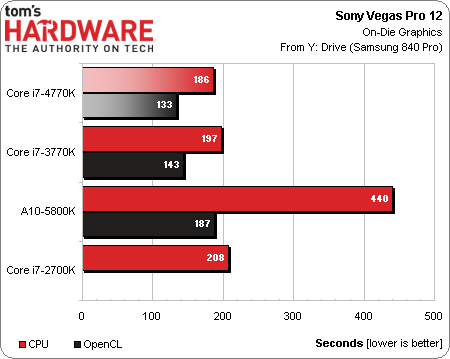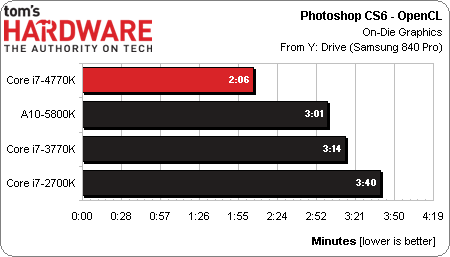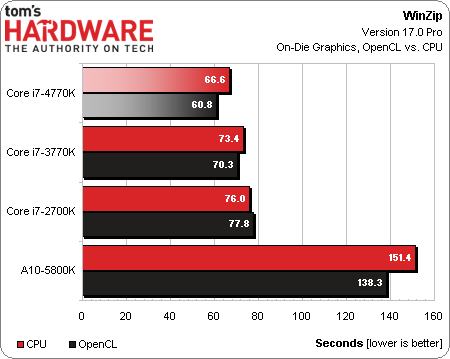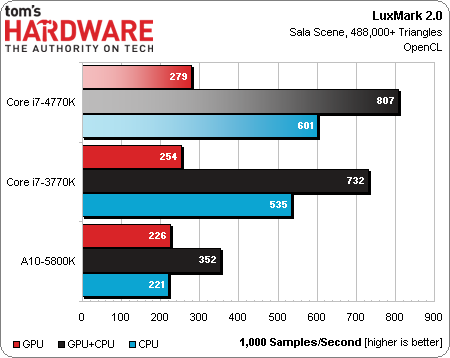The Core i7-4770K Review: Haswell Is Faster; Desktop Enthusiasts Yawn
Intel's Haswell architecture is finally available in the flagship Core i7-4770K processor. Designed to drop into an LGA 1150 interface, does this new quad-core CPU warrant a complete platform replacement, or is your older Sandy Bridge-E system better?
HD Graphics 4600: Impressive OpenCL
These days, we think beyond 3D when someone starts talking about graphics processing. Heterogeneous computing is gaining traction, and there’s an increasingly large library of applications we’re able to test featuring OpenCL support.
Intel shipped its first OpenCL-capable drivers for the Sandy Bridge-era CPUs, though they only supported the processor. With Ivy Bridge, the company added HD Graphics 2500/4000 compatibility, allowing developers to leverage the x86 cores or symmetric execution units for general-purpose computing tasks. Haswell gets OpenCL 1.2 compliance (as does Ivy Bridge thanks to the latest driver package), along with performance improvements for OpenCL kernels running on the CPU and HD Graphics engine. What’s the result? There’s an app for that (several, actually)!
Each platform is running on integrated graphics, without interference from a discrete GPU.
Let’s start with Sony Vegas Pro 12. Because its graphics component isn’t supported, Intel’s Core i7-2700K sets our baseline with CPU-only results. Stepping up to the -3770K yields moderate gains based on architectural tweaks. But it’s not until we harness HD Graphics 4000 that the workload gets more than 50 seconds hacked out of it. Core i7-4770K furthers those gains with HD Graphics 4600.
This isn’t a story about AMD, but A10-5800K steals the show a bit by taking a relatively anemic dual-module processor and supercharging it with Radeon graphics, cutting the task by more than half. The Trinity-based APU is about as fast as Haswell without OpenCL enabled, though it’d be fairer to simply say it beats Core i7-2700K, since Sandy Bridge can’t benefit from OpenCL support.
You’ll see more of this benchmark later in the story when we drop a GeForce GTX Titan into each platform. Driven only by integrated graphics, though, Haswell smokes its predecessor through a combination of faster x86 cores and a larger graphics component. AMD’s A10-5800K finishes second, ahead of the much pricier Core i7-3770K.
Another popular general-purpose title, WinZip is mildly accelerated by OpenCL. Only certain files (those larger than 8 MB) benefit from heterogeneous computing, so the impact of OpenCL on a compression test is wholly workload-dependent. Nevertheless, we see another example of Haswell faring well against prior generations and AMD’s APU.
Get Tom's Hardware's best news and in-depth reviews, straight to your inbox.

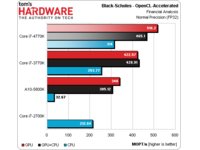
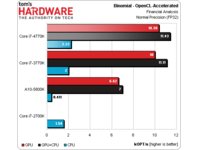
These thumbnails represent three mathematical models for estimating the future worth of options. I ran them all at FP32 precision. They universally show Core i7-4770K at the top of our four-contender stack, with A10-5800K and Core i7-3770K trading blows underneath.
Because SiSoftware’s Sandra 2013 lets me isolate CPU, GPU, and combined acceleration, we see that a CPU working alone in these calculations is really pretty slow. The HD Graphics engine is where it’s at. And, in some cases, adding capable x86 cores on top of that does help improve the outcome.
CPU performance makes the most significant difference in LuxMark, though combining the effects of both subsystems is pretty powerful, too. For the sake of comparison, if you have a single GeForce GTX Titan installed, you get about 1,300 K samples/sec. That’s only 60% or so faster than a Core i7-4770K and its on-die graphics.
It may not be leading the field in 3D performance, but Intel certainly deserves credit for its work with OpenCL.
Current page: HD Graphics 4600: Impressive OpenCL
Prev Page HD Graphics 4600: 3D And Quick Sync Next Page HD Graphics 4600: Battlefield 3-
Danny N Biggest question is if its worth upgrading my cpu i5 750 4.0ghz to Haswell or my gfx card ati 5870 to nvidia 7xx, my main pc use is for Maya, After FX and some fps gaming. Any input would be appriciated cause I'm leaning towards a cpu upgrade atm.Reply -
refillable @Danny NReply
You shouldn't ask here. Perhaps you should get an i7-4770k and a 7970(?) I heard that kepler cards does not perform that good in Maya and Aftereffects (In OpenCL). -
envy14tpe Seriously. What did people expect? Of course it's better but nothing out of the ordinary for Intel.Reply -
enewmen For me it's not about the 10% gain over SB. It's more like a huge gain over a C2Q, floating point performance over SB (should matter later), and lower watts. I hope THG can expand the Power Consumption and Media Encoding later - check the Watts idle more and fast quick-sync media encoding quality loss. My 2 cents..Reply
EDIT:
other sites have reported much lower watts idle, so a lot doesn't make sense or the 4770k has a very slow throttle.
http://hexus.net/tech/reviews/cpu/56005-intel-core-i7-4770k-22nm-haswell/?page=15
http://www.techspot.com/review/679-intel-haswell-core-i7-4770k/page13.html
